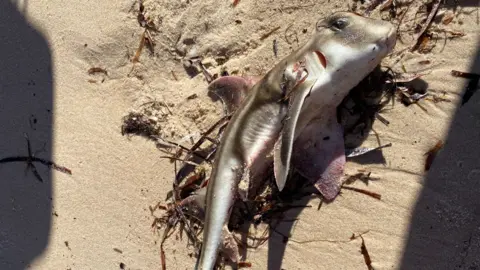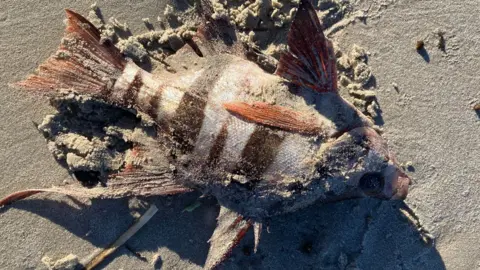Toxic algae kills more than 200 marine species in Australia
 Cassie Price via Ozfish Unlimited
Cassie Price via Ozfish UnlimitedMore than 200 marine species off the coast of South Australia (SA) have been killed by a weeks-long toxic algae explosion, in what conservationists have described as "a horror movie for fish".
The algal bloom - a rapid increase in the population of algae in water systems - has been spreading since March, growing to about 4,500 sq km (3,400 sq miles), or roughly the size of nearby Kangaroo Island.
"It's an unprecedented event, because the bloom has continued to build and build," said Vanessa Pirotta, a wildlife scientist.
Other scientists say the algae produces poisons which "act like a toxic blanket that suffocates" a wide range of marine life, including fish, rays and sharks.
Brad Martin, SA project manager for OzFish, a non-profit organisation that protects fishing habitats, said that while algal blooms are not uncommon, the "massive" scale of the current event has had a dramatic impact on marine life.
Toxins produced by the algae can cause "gill and tissue damage" by attacking the red blood cells, Mr Martin told the BBC.
The large density of the bloom also means that oxygen is being taken out of the water, "so we know that the fish are suffocating".
"It is like a horror movie for fish," he said.
The event has been widely documented by people sending in pictures of dead wildlife washed up on beaches.
 Cassie Price via Ozfish Unlimited
Cassie Price via Ozfish UnlimitedThe effect on sharks and rays has been particularly graphic, with large numbers washing up on beaches "bright red", showing indications of haemorrhaging.
A three-metre great white shark was among those found dead in recent weeks.
Among the more than 200 species that have been killed, which range from the smallest of baby fish to great whites, some are more vulnerable than others.
Reef species like crabs and pufferfishes have been the worst hit, as they are less mobile and can't swim away from the toxic algae.
While the algae isn't harmful to humans, those exposed to high doses can experience skin irritation and respiratory symptoms such as coughing or breathing issues.
The SA government has advised people to avoid swimming at beaches where there is discoloured water and foam.
Algal blooms occur during sunny and warm conditions, and SA has had a marine heatwave since last September, with temperatures about 2.5 degrees warmer than average.
Australia has also been experiencing unseasonably warm conditions since March, which has further driven the size and duration of the current algal bloom.
The last time SA recorded a large event of this type of toxic algae was in 2014, according to the state's environment and water department.
The spread has also affected some commercial fisheries, which have pre-emptively closed harvest areas.
Local coastal businesses have also seen a dip in visitors due to the sheer number of dead marine life washing up on shore.
Meanwhile, researchers and the SA government are continuing to monitor the bloom as it moves west.
